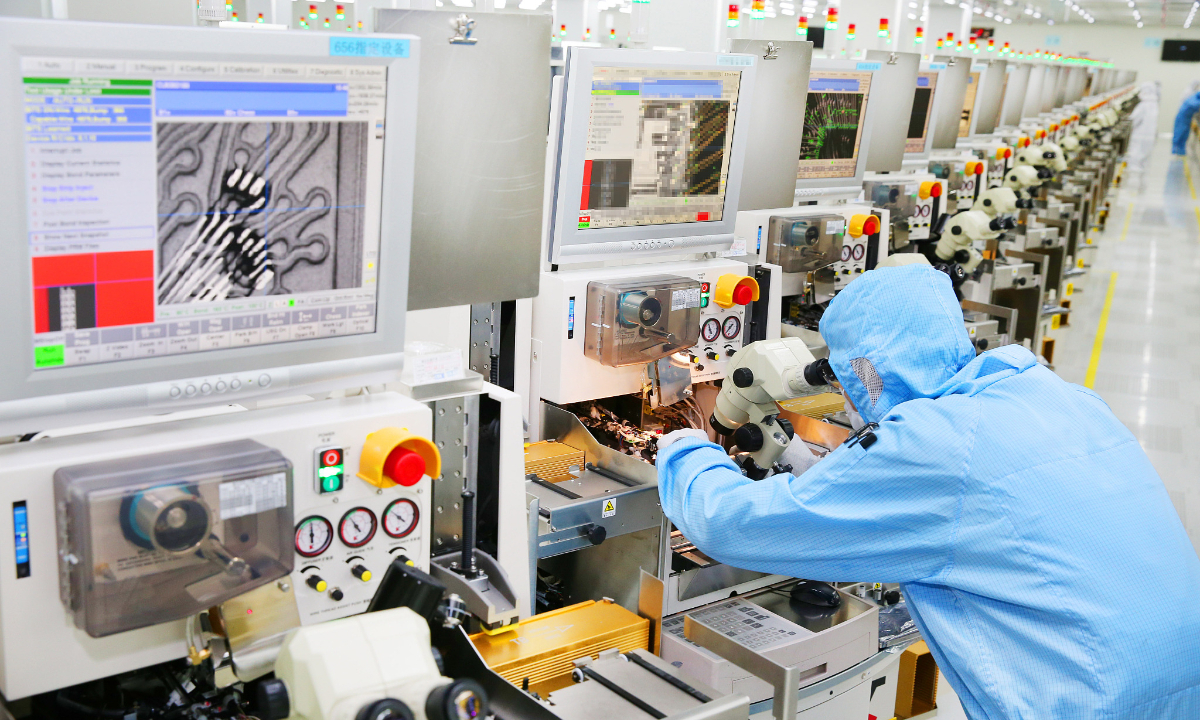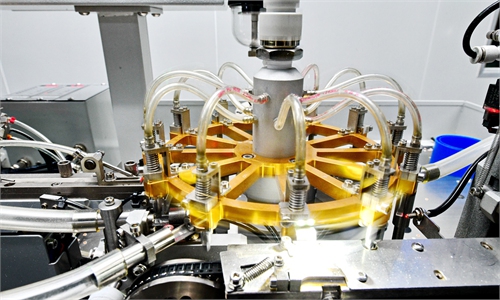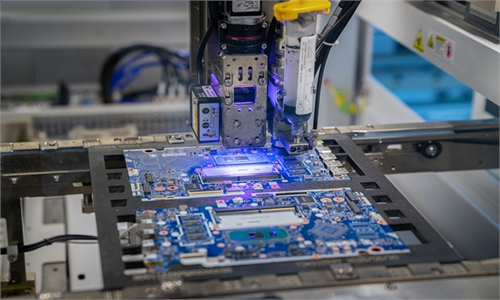Japan's proposed export controls on semiconductors to disrupt supply chain, undermine economic order

An engineer analyzes chips at a chip factory in Nantong, East China's Jiangsu Province in February. Photo: VCG
On March 31, 2023, the Japanese Ministry of Economy, Trade and Industry (METI) announced its plan to revise the Foreign Exchange and Foreign Trade Act (FEFTA) to expand the scope of chip manufacturing equipment that requires prior approval by the METI before export. Export controls should be a tool to maintain world peace, stability, security and development instead of a curb on industrial cooperation or scientific and technological exchanges. This revision of rules by Japan runs contrary to the rules of industrial development and the aim of the export control system, and will undermine the stable operation of the global semiconductor industry and supply chains. Faced with challenges of global industrial development and transformation and de-globalization, the right choice for China and Japan both would be embracing openness for win-win cooperation.
First, China-Japan economic and trade cooperation has been mutually beneficial over a long time.
The year 2023 marks the 51st anniversary of the normalization of diplomatic relations between China and Japan. Looking back, China-Japan relations have experienced ups and downs, but the bilateral economic and trade cooperation has generally enjoyed healthy development: the bilateral trade volume between China and Japan increased by more than 300 times, and the amount of FDI from Japan in China exceeded $120 billion. There are more than 30,000 Japanese enterprises in China. Since 2007, China has been Japan's largest trading partner. With the changes of the world political and economic landscape, the scope of economic and trade cooperation between China and Japan has broadened and prospered through multiple channels, with increasing diversity and higher quality. It has been proved by history and experience that despite many ups and downs, bilateral economic and trade cooperation has always been the ballast and propeller of China-Japan relations.
China is Japan's largest trading partner and its largest export market. China-Japan trade accounts for more than one-fifth of Japan's total foreign trade. The balance of trade in goods between China and Japan shows the complementarity of the industrial structures of the two sides. China's trade with Japan in textiles, consumer food products, and household appliances, are generally in surplus, while China's trade with Japan in automobiles, chemical industrial products, and metal raw materials are generally in deficit. China has become an important driver for Japan's foreign trade and economic growth. Japan's market ecosystem now faces weak domestic demand, deflation, and corporate tax hikes. In comparison, China's advantages of vast markets, sustained economic growth, a complete industrial system, and further opening up to the outside world can offer strong support to Japan in its industrial transfer, development of emerging industries, and optimization and upgrading of industrial structures.
Cooperation on semiconductors is one of the most representative examples of mutual benefits from China-Japan economic and trade ties. On one hand, Chinese mainland is the largest export destination for Japanese semiconductor equipment manufacturers. In 2022, the amount of semiconductor manufacturing equipment exported from Japan to Chinese mainland exceeded 820 billion yen ($6.02 billion), about 30 percent of Japan's total semiconductor exports. Japan's export of semiconductor manufacturing equipment to China almost doubles the amount of US export in the same sector to China.
On the other hand, there are various channels and methods of cooperation in the semiconductor industry between China and Japan, including building industrial parks, demonstration areas, and matchmaking between platforms. A large number of Japanese companies have invested and built factories in China. Japanese companies involved in semiconductor materials import a large amount of important raw materials from China and have established a huge supply chain system in China. It is clear that the trend of continuous expanding cooperation in the semiconductor sector between China and Japan is in the interests of both sides.
Second, Japan's planned export control measures will undermine the normal economic and trade order.
According to the draft of the METI, Japanese exporters can export six categories (23 types) of chip manufacturing equipment with licenses to 42 countries and regions, including the US and Singapore. However, the export of such products to other countries and regions, including China, requires case-by-case approval from the government. These new rules are scheduled to apply to inward direct investment and equivalent actions to be made on or after May 24. The controlled equipment includes essential tools for producing semiconductor chips, such as lithography machines, chemical vapor deposition equipment and etching machines. Due to the wide application of semiconductor chips in modern industry, this restrictive measure will have a profound impact on the development of the semiconductor industry in China and Japan.
The new measures go against market rules. Over recent years, Japan has enhanced its economic security through legislation, constructed exclusive economic and trade rules, strengthened investment review and export control, creating obstacles to in-depth semiconductor cooperation between China and Japan. The real purpose of such policies is only to obtain a ticket to squeeze into a certain camp. However, this disregard for the development rules of the market comes at a great cost. The new restrictions, once implemented, will bring uncertainty to healthy market competition and deep cooperation between Chinese and Japanese semiconductor industries, and will certainly cause huge losses for Japanese companies.
The new measures will cause shocks to industrial development. By expanding the scope of export controls on semiconductor manufacturing equipment, Japan has brought a number of civilian devices under such controls to target China. The intention of such behavior is obvious: Japan aims to cooperate with the US in the malicious suppression of technology from China. Semiconductor is a highly globalized industry. The formation and development of its industrial and supply chains is a result of a number of factors, including market rules and choices by businesses. The semiconductor industry has developed to today's level so that no country can alone master every step for the production of high-end chips. What supports the development of the semiconductor industry is a huge global industrial network, whose smooth operation requires Japan, the US, South Korea, Europe and other regions, and the close cooperation with China. The current demand in the global semiconductor market is plummeting, and the demand for components and equipment remains low. Japan's new measures will disrupt the global semiconductor supply chain in the short term, and they will certainly reduce the overall competitiveness of the Japanese semiconductor industry in the long term, resulting in an imbalance in the global semiconductor industry.
New measures are contrary to the aims of export control. This new list of controlled items by Japan is extremely wide-ranging, and the end use of many items would be the production of consumer electronics, not military devices. Such an expansion of controlled items has significantly deviated from the fundamental purpose of export control - anti-proliferation, and directly disturbs the normal cooperation in international trade and economy. The items to be controlled by Japan has exceeded the scope of Wassenaar Arrangement and other internationally accepted rules on controlled items, including a large amount of equipment used for lithography, etching, thermal treatment, cleaning, testing, etc. The revised list of items is more extensive than those of other countries, which will have a bad impact on normal economic activities of semiconductor enterprises. It is a great challenge to globalization and free trade, while meaning little to the anti-proliferation obligations of a major country and the maintenance of international peace and security.
Third, openness and cooperation is the right thing to do.
The technology competition among major countries has long existed, while the trend of globalization and industrial division of labor is inexorable. Unilateral moves by any country can hardly change the economic interdependence of all countries. Forced decoupling and severing supply chains, which could have serious consequences, should be rejected. Therefore, only through dialogue, consultation and crisis management can countries establish mutually beneficial norms and rules and avoid the negative consequences for all from confrontation, and gradually find a way that balances national security and economic interests. The Japanese government should stay cool-headed and prudent, fully consider the development interests of all at home and abroad, and make the right decisions to maintain the stability of the global supply and industrial chain.
China has the world's largest consumer market and technology market. Market is the ultimate destination of scientific and technological achievements, and the lever that guides and regulates technology transfer. It dominates the domestic and international flow of mature and practical technologies as well as new technologies, methods and techniques. The industrial structure of China and Japan is highly complementary, and the production and supply systems are strongly linked. The combination of China's market advantages and Japan's technological advantages would create a new vision of China-Japan economic and technological cooperation. In addition, China and Japan, as members of RCEP, will expand the proportion of zero-tariff goods exported to each other from 8 percent to 86 percent. The tariff reduction will certainly deepen cooperation in the semiconductor industry and serve related industries upstream and downstream.
China and Japan should strengthen the international division of labor in the semiconductor industrial chain between the two by promoting the implementation of the RCEP free trade cooperation mechanism. They should respect market rules, broaden communication channels, and enhance political mutual trust to break the trap of abusing the concept of national security in economic issues, so as to follow the trend of globalization and achieve the convergence of interests of both sides in the semiconductor industry. The two countries should also strengthen coordination and cooperation in economic policies, explore mutually beneficial, win-win and diversified cooperation opportunities, continue to promote and deepen bilateral cooperation in trade, investment and economy, actively maintain and expand bilateral and multilateral trade relations, and jointly address the challenges of global industrial changes and de-globalization.
The author is from Chinese Academy of International Trade and Economic Cooperation, Ministry of Commerce. opinion@globaltimes.com.cn



